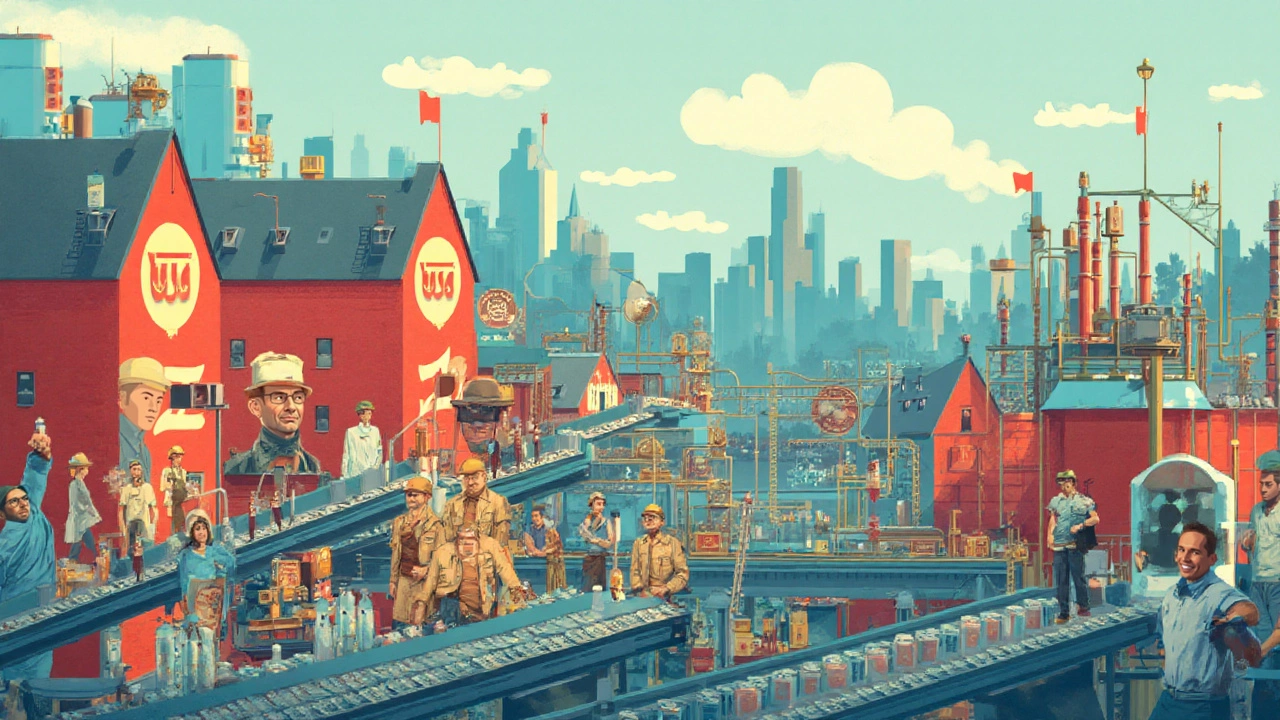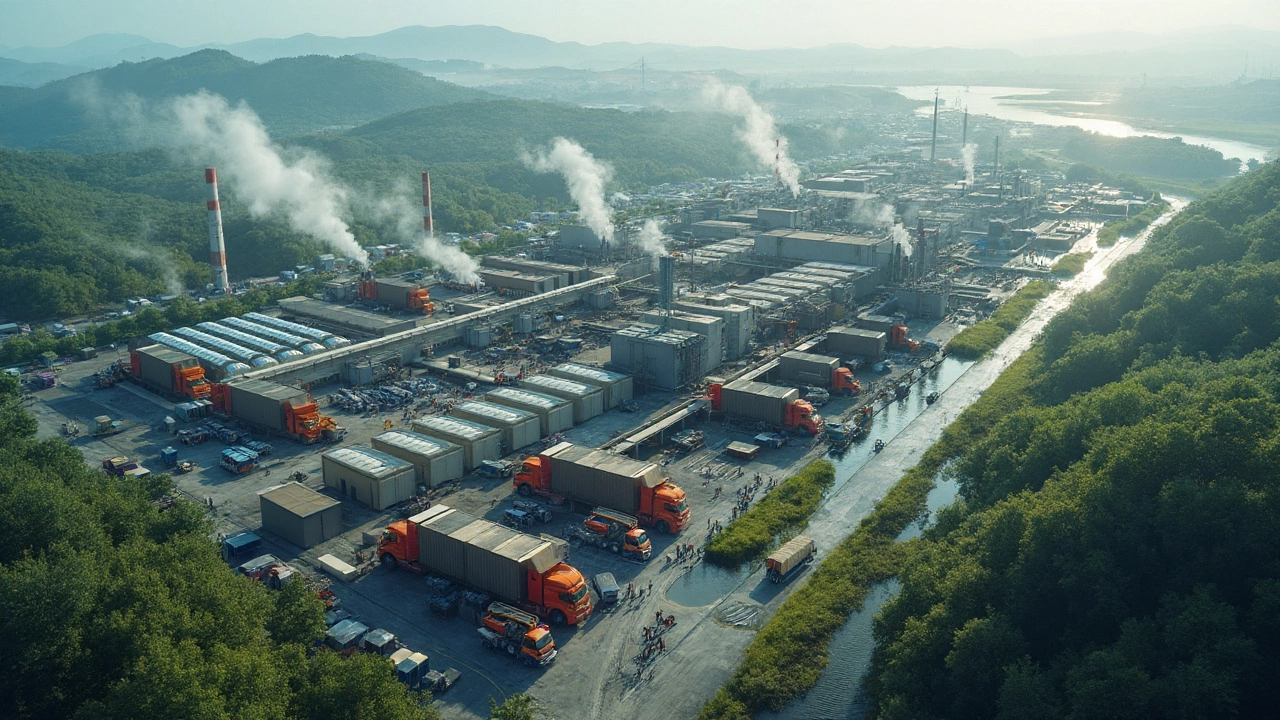Nothing screams modern life like plastic. It’s tangled in almost everything we use—phone cases, car parts, toothbrushes, and even those annoying tamper-proof bottle caps you battle every morning. But have you ever wondered: where do all these plastics actually begin their journey? If you want to picture giant machines, chemical fumes, and conveyor belts stretching until your eyes hurt, you’d be pretty close to reality. Digging deeper, it turns out that America’s plastic story is woven through certain cities, states, and entire regions, but it doesn’t start or end where you might expect.
How the US Became a Powerhouse in Plastic Manufacturing
Before the US could flood the world with Tupperware, toys, and sneaker soles, it had to become a serious player in the game of making plastic. The story kicked off in the early 20th century when American companies, fueled by the oil boom and chemical innovation, jumped into polymer development. Bakelite, the world’s first synthetic plastic, was invented in 1907 in New York, setting the tone for non-stop growth. Oil refineries and natural gas facilities in Texas and Louisiana found clever ways to use byproducts, eventually morphing entire regions into plastic wonderlands. During World War II, American plastic production exploded for military gear, canteens, and parachutes. Post-war, the industry pivoted to consumer goods almost overnight, and ever since, the US hasn’t slowed down.
Today, the country is second only to China in plastic output, cranking out roughly 125 billion pounds of resin every year. According to the Plastics Industry Association, the US plastic sector supports nearly a million jobs and injects over $400 billion into the economy annually. With such colossal numbers, manufacturing didn’t just stick to one place; it spread into sprawling hubs where energy, ports, skilled labor, and freight lines lined up perfectly.
plastic manufacturing got a massive boost because the US sits on top of rich fossil fuel reserves, but it’s the accessibility and interconnected supply chains—think refineries, chemical plants, and factories all bundled together—that really set the stage. Each major hub developed a personality of its own, shaped by raw material access, port locations, regulations, and—even now—growing pressure over sustainability.
| State | Annual Plastic Output (Billion lbs) | Major Plastic Products |
|---|---|---|
| Texas | 31 | Resins, packaging, automotive parts |
| Louisiana | 22 | PVC, film, pellets |
| Ohio | 14 | Molded parts, pipes, construction |
| Illinois | 11 | Food containers, medical supplies |
| California | 10 | Consumer goods, packaging, toys |
Biggest Plastic Manufacturing Regions and Their Stories
The US doesn’t play favorites, but if it did, the Gulf Coast would win gold. The stretch from Houston, Texas to New Orleans, Louisiana, is sometimes called "Plastic Alley." Here, raw petroleum streams straight from pipelines into the hearts of giant multi-acre refineries and chemical complexes. Have you heard of ExxonMobil or Dow? Their biggest resin plants call this region home. Houston’s Bayport Industrial District houses one of the largest concentrations of plastics and chemicals plants in the world, not just the country.
Sliding over to the Midwest, Ohio and Illinois pop up as major players too. Why? Manufacturing, not just of resins but of finished parts—think car bumpers, medical syringes, and everything you knock over in a dollar store. Places like Akron (once obsessed with tyres) and Cleveland have retooled old industries and trained workforces to make plastics instead of just rubber or metal. This combo of legacy skills and new tech has kept them right at the heart of US plastics.
California brings its own flavor. Los Angeles County by itself has over 1,000 plastics plants. The West Coast’s gateway ports make importing raw materials and shipping finished goods worldwide super cheap. Size helps, but so does local demand—California chews through tons of food trays, bottles, film, and retail packaging every day. Add in startups focused on bioplastics in Silicon Valley, and California’s plastics treadmill never stops turning.
What about the Northeast? Places like New Jersey, Pennsylvania, and upstate New York have deep roots in specialty plastics—like those transparent tubs for your lunch, or hard plastics in medical devices. A lot of this is thanks to proximity to big pharmaceutical and tech companies, along with research powerhouses like MIT and Cornell pumping out IP and talent to fuel innovation.
One quirky fact—according to a 2023 American Chemistry Council report, over 60% of US plastic jobs are situated within 500 miles of the Gulf Coast, with Texas alone claiming around one-quarter of all the country’s plastics exports. This isn’t just about oil; it’s about logistics. Give a factory quick access to cheap ethylene, shipping lanes, and nearby buyers, and it’ll make more than enough plastic to wrap the world in bubble wrap ten times over.

Major US Plastic Producers and the Products They Make
You can’t talk plastic in the US without mentioning the kingpins: Dow (now officially Dow Inc.), ExxonMobil, LyondellBasell, Chevron Phillips, Eastman Chemical, and Westlake Chemical, to name a few. These guys control eye-watering stretches of land along the Texas and Louisiana coasts, where mile-long extrusion lines churn out the resin pellets that eventually become bin bags, piping, sneakers, and even COVID-19 testing kits.
Dow’s Freeport, TX plant often lands on lists of the world’s biggest single-site chemical facilities. Picture twenty football fields glued together; that’s about the scale. ExxonMobil’s Baton Rouge complex in Louisiana is almost a city by itself, with its own roads and railway lines for shifting everything from polyethylene to PVC. LyondellBasell, a Dutch-American firm, does most of its North American resin cooking in Texas, right near Houston.
Shifting north, Berry Global (headquartered in Indiana) flies under the radar yet manages to be one of the world’s top consumer plastic packaging producers—they make everything from trash bags to medical vials to beverage closures. Over in the Midwest, PolyOne (now Avient) in Ohio makes specialized plastic compounds, from anti-static phone cases to ultra-clear food packaging.
What sets the US apart is how integrated all these giants are—raw material suppliers, resin integrators, and finished goods plants often sit side-by-side (sometimes literally connected by underground pipes or rails). This interconnectedness slashes costs and speeds up innovation, so new formulations or more sustainable products can hit the market lightning fast.
The FDA’s 2024 update on medical device plastics specifically called out American-made medical polymers for their quality and reliability—which matters if you’re looking for sterile packaging or parts that can survive in your body for years. According to the report, “US-made medical plastics deliver unmatched consistency and safety, making them the first choice for hospitals in over 50 countries.”
“The integration of petrochemical supply, resin formation, and downstream manufacturing in Texas and Louisiana gives US plastics a global edge,” says Dr. Rachel Glick, senior industry analyst at IHS Markit.
Why Are These Places Chosen for Plastic Factories?
It might sound random, but the math is precise. First, you want to be close to oil and gas, because plastic—at its boring core—is mostly made from ethylene and propylene, both of which come straight out of cracked petroleum and natural gas. That’s why the Gulf Coast, flush with refineries, has such a gravitational pull. Companies save millions just by shaving off transit miles for these heavy, hazardous raw materials.
Next, imagine you need to ship finished resin and plastics to furniture makers, car factories, or that endless Amazon warehouse outside Dallas. It helps if your plant sits near a port (Houston and New Orleans are both monsters in cargo volume), and even better if you’re close to major railroad links. Saving a few cents per pound in transport, multiplied by millions of tonnes, can mean the difference between red and black for a manufacturer.
Cheap and skilled labor is huge. The regions with deep industry roots keep attracting new generations into plastics—schools around Houston and Baton Rouge even offer high school tracks in polymer science. Meanwhile, the Midwest still punches above its weight thanks to its legacy of building stuff—wrenches, engines, then car dashboards and truck liners.
State regulations shape the map too. Texas is famously business-friendly. Louisiana rolls out tax credits for any manufacturer willing to invest in big industrial parks. California, meanwhile, keeps things eco-tight, pushing producers to focus on “greener” plastics or risk huge fines and public shaming. Wherever government can grease the wheels—on taxes, permits, or workforce training—you’ll find plastics making itself right at home.
Then there’s the customer base. You go to California for food packaging and consumer gadgets, because that’s where the market is. You plop another factory in the Midwest if you’re aiming at automakers, appliance giants, or food processors. In short: the setup isn’t by accident, and it keeps evolving as markets and materials shift.

Challenges Facing US Plastic Manufacturing and What’s Next
No one’s giving the industry a free ride. Worries about plastic pollution, global trade spats, and even energy crises have pushed US producers to rethink how and where they make plastics. Since 2020 alone, over 65 new or expanded US plastic projects have included investments in recycling tech or “circular economy” systems, according to an MIT sustainability report.
Public pressure is real: cities like Seattle, San Francisco, and New York have kicked out plastic shopping bags, leading to waves of rethinking in packaging. Lawmakers in more states keep tossing out single-use bans and threatening taxes. Companies are racing for new formulas, like those made from corn or algae, or even plastics that simply melt away into nothing.
Supply chain shocks are a headache too. Hurricane Laura in 2020 knocked out almost half of US resin output for weeks—it took months to recover. That kind of risk is leading firms to build extra factories away from the coast or invest more heavily in automation and digital controls. Meanwhile, American know-how in material science keeps the country ahead, especially on high-tech applications like 3D printing, medical innovations, or super-light automotive frames.
Still, America’s advantage stays strong. The blend of homegrown resources, infrastructure, and engineering smarts is hard to beat, but it only works if local communities, green activists, and regulators let it. Trends point to even more rapid change: more recycling, more renewable energy use, and faster leaps in plastic “smartness”—biodegradable, self-healing, even electrically active polymers are in the pipeline.
So if you’re looking at the next bottle, car dashboard, or snack wrapper, odds are it rolled off a line in Texas, Louisiana, Ohio, Illinois, or California. That’s not by accident, but by decades of decision-making, investment, and adaptation. The US plastic map might grow messier, but it’s far from finished shaping our daily lives.
